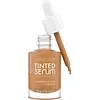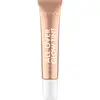What's inside
What's inside
 Key Ingredients
Key Ingredients

 Benefits
Benefits

 Concerns
Concerns

 Ingredients Side-by-side
Ingredients Side-by-side

Water
Skin ConditioningIsododecane
EmollientDimethicone
EmollientGlycerin
HumectantC12-15 Alkyl Benzoate
AntimicrobialPEG-10 Dimethicone
Skin ConditioningHydrogenated Polydecene
EmollientDimethicone Crosspolymer
Emulsion StabilisingButylene Glycol
HumectantCetyl PEG/PPG-10/1 Dimethicone
EmulsifyingSilica
AbrasiveTrimethylsiloxysilicate
EmollientTocopheryl Acetate
AntioxidantSodium Hyaluronate
HumectantSodium Chloride
MaskingMagnesium Sulfate
Triethoxycaprylylsilane
Disteardimonium Hectorite
StabilisingMethicone
EmollientPropylene Carbonate
SolventEthylhexylglycerin
Skin ConditioningPhenoxyethanol
PreservativeSodium Benzoate
MaskingSodium Dehydroacetate
PreservativeBenzoic Acid
MaskingDehydroacetic Acid
PreservativeAluminum Hydroxide
EmollientCI 77491
Cosmetic ColorantCI 77492
Cosmetic ColorantCI 77499
Cosmetic ColorantCI 77891
Cosmetic ColorantWater, Isododecane, Dimethicone, Glycerin, C12-15 Alkyl Benzoate, PEG-10 Dimethicone, Hydrogenated Polydecene, Dimethicone Crosspolymer, Butylene Glycol, Cetyl PEG/PPG-10/1 Dimethicone, Silica, Trimethylsiloxysilicate, Tocopheryl Acetate, Sodium Hyaluronate, Sodium Chloride, Magnesium Sulfate, Triethoxycaprylylsilane, Disteardimonium Hectorite, Methicone, Propylene Carbonate, Ethylhexylglycerin, Phenoxyethanol, Sodium Benzoate, Sodium Dehydroacetate, Benzoic Acid, Dehydroacetic Acid, Aluminum Hydroxide, CI 77491, CI 77492, CI 77499, CI 77891
Water
Skin ConditioningSynthetic Fluorphlogopite
Mica
Cosmetic ColorantSqualane
EmollientPropanediol
SolventGlycerin
HumectantAmmonium Acryloyldimethyltaurate/Vp Copolymer
Sodium Ascorbyl Phosphate
AntioxidantPanthenol
Skin ConditioningNiacinamide
SmoothingGlyceryl Rosinate
PerfumingSilica
AbrasiveXanthan Gum
EmulsifyingEthylhexylglycerin
Skin ConditioningSodium Phytate
Cellulose
AbsorbentSodium Sulfate
Lactic Acid
BufferingCitric Acid
BufferingPhenoxyethanol
PreservativeTin Oxide
AbrasiveCI 77491
Cosmetic ColorantCI 77891
Cosmetic ColorantWater, Synthetic Fluorphlogopite, Mica, Squalane, Propanediol, Glycerin, Ammonium Acryloyldimethyltaurate/Vp Copolymer, Sodium Ascorbyl Phosphate, Panthenol, Niacinamide, Glyceryl Rosinate, Silica, Xanthan Gum, Ethylhexylglycerin, Sodium Phytate, Cellulose, Sodium Sulfate, Lactic Acid, Citric Acid, Phenoxyethanol, Tin Oxide, CI 77491, CI 77891
 Reviews
Reviews

Ingredients Explained
These ingredients are found in both products.
Ingredients higher up in an ingredient list are typically present in a larger amount.
Ci 77491 is also hydrated iron III oxide. It's sole purpose is to give a red/pink hue to products.
Iron III oxides are classified as inorganic chemicals for coloring.
Synthetically created Ci 77491 is considered safer than those naturally found. This is because the synthetically created version may contain less impurities. Iron oxides are generally non-toxic and non-allergenic.
Learn more about CI 77491Ci 77891 is a white pigment from Titanium dioxide. It is naturally found in minerals such as rutile and ilmenite.
It's main function is to add a white color to cosmetics. It can also be mixed with other colors to create different shades.
Ci 77891 is commonly found in sunscreens due to its ability to block UV rays.
Learn more about CI 77891Ethylhexylglycerin (we can't pronounce this either) is commonly used as a preservative and skin softener. It is derived from glyceryl.
You might see Ethylhexylglycerin often paired with other preservatives such as phenoxyethanol. Ethylhexylglycerin has been found to increase the effectiveness of these other preservatives.
Glycerin is already naturally found in your skin. It helps moisturize and protect your skin.
A study from 2016 found glycerin to be more effective as a humectant than AHAs and hyaluronic acid.
As a humectant, it helps the skin stay hydrated by pulling moisture to your skin. The low molecular weight of glycerin allows it to pull moisture into the deeper layers of your skin.
Hydrated skin improves your skin barrier; Your skin barrier helps protect against irritants and bacteria.
Glycerin has also been found to have antimicrobial and antiviral properties. Due to these properties, glycerin is often used in wound and burn treatments.
In cosmetics, glycerin is usually derived from plants such as soybean or palm. However, it can also be sourced from animals, such as tallow or animal fat.
This ingredient is organic, colorless, odorless, and non-toxic.
Glycerin is the name for this ingredient in American English. British English uses Glycerol/Glycerine.
Learn more about GlycerinPhenoxyethanol is a preservative that has germicide, antimicrobial, and aromatic properties. Studies show that phenoxyethanol can prevent microbial growth. By itself, it has a scent that is similar to that of a rose.
It's often used in formulations along with Caprylyl Glycol to preserve the shelf life of products.
Silica, also known as silicon dioxide, is a naturally occurring mineral. It is used as a fine, spherical, and porous powder in cosmetics.
Though it has exfoliant properties, the function of silica varies depending on the product.
The unique structure of silica enhances the spreadability and adds smoothness, making it a great texture enhancer.
It is also used as an active carrier, emulsifier, and mattifier due to its ability to absorb excess oil.
In some products, tiny microneedles called spicules are made from silica or hydrolyzed sponge. When you rub them in, they lightly polish away dead skin layers and enhance the penetration of active ingredients.
Learn more about SilicaWater. It's the most common cosmetic ingredient of all. You'll usually see it at the top of ingredient lists, meaning that it makes up the largest part of the product.
So why is it so popular? Water most often acts as a solvent - this means that it helps dissolve other ingredients into the formulation.
You'll also recognize water as that liquid we all need to stay alive. If you see this, drink a glass of water. Stay hydrated!
Learn more about Water